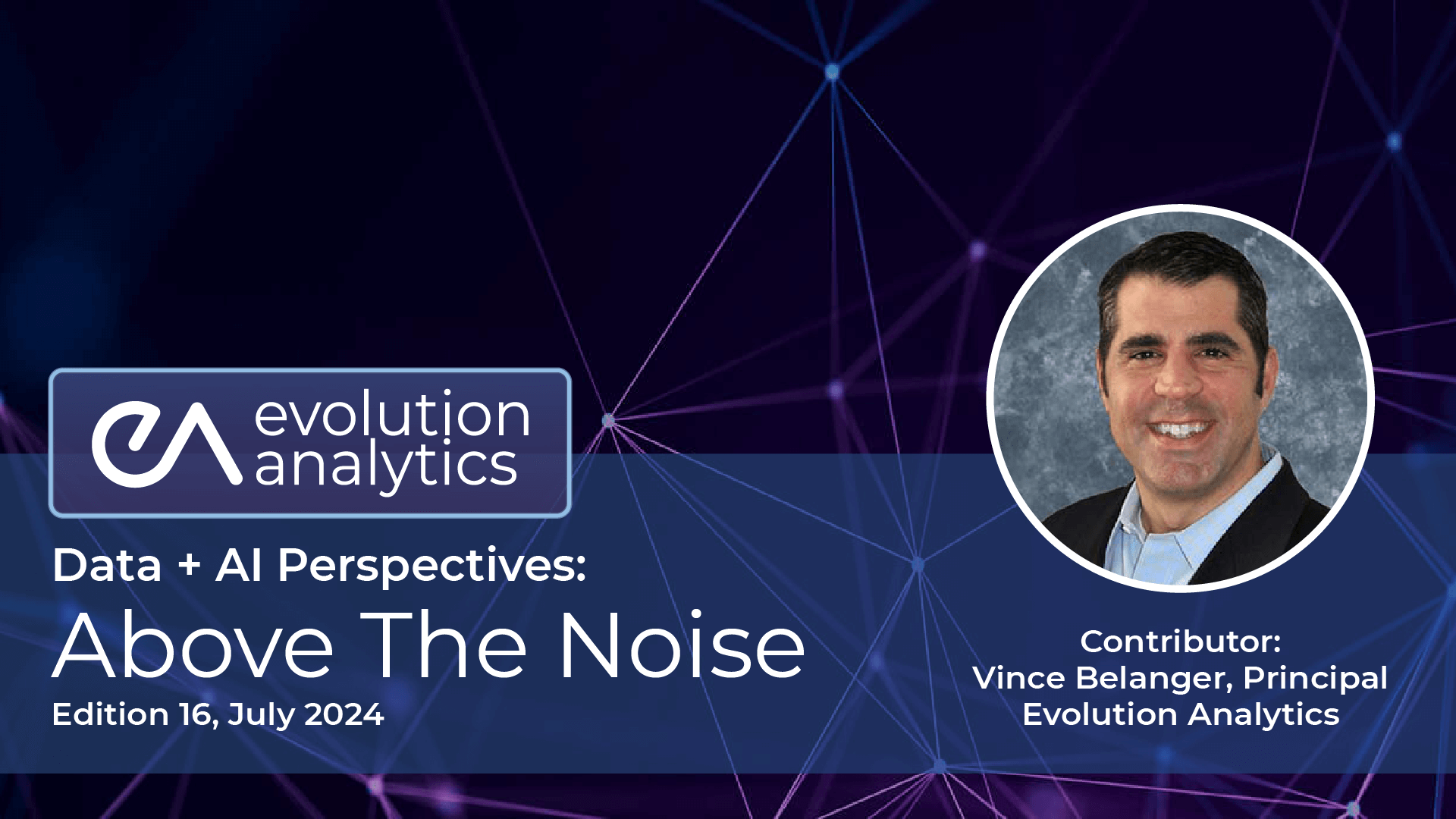Navigating the Digital Shift: Strategic AI Integration for Business Impact

Vince Belanger
Principal
Evolution Analytics, LLC.
Posted: July 9, 2024
The imperative for businesses to harness technology has never been more pressing. This is particularly true when it comes to artificial intelligence (AI), the latest frontier in a progression that has seen data handling capabilities shift from basic data warehousing to sophisticated AI-driven analytics. While the technologies have evolved, the core challenge remains the same: aligning these powerful tools with specific business goals to drive meaningful outcomes.
You might find this hard to believe, but the strategic approach to integrating these technologies hasn’t changed as drastically as the technologies themselves. Whether it’s business intelligence (BI), big data, or now AI, the foundational steps of aligning technology with business objectives remain consistent. However, the introduction of AI promises a substantially greater impact in the long run. Not only does AI have the potential to significantly transform business processes, but it also offers unprecedented value over time, far surpassing the capabilities of traditional BI and big data solutions. This enhanced impact stems from AI’s ability to learn and adapt, continuously improving and thereby driving sustained business transformation and growth.
Understanding the Evolution from BI to AI: Key Constants
Historically, business intelligence tools expanded rapidly, offering increased computing power and a vast landscape of software solutions. These advancements enabled companies to handle large volumes of data and democratized access to information. Yet, the challenge of selecting the right tools to meet diverse business needs became more complex.
Today, with AI, you face similar choices but with far greater stakes due to AI’s potential impact on decision-making and operational efficiency. Just as with earlier BI tools, aligning AI solutions with your business needs requires a methodical approach:
- Assess Requirements: Clearly define what your AI solution needs to achieve by first understanding the business value and the ‘why’ behind your objectives. Does it need to process real-time data for immediate insights, or manage vast amounts of unstructured data for complex analyses? Knowing the purpose—whether it’s enhancing customer experience, optimizing operational efficiency, or driving innovation—will guide your technology choices and ensure that the AI solution not only supports but actively advances your strategic business objectives. This deep understanding of the ‘why’ ensures that the solution aligns with both immediate needs and long-term business goals.
- Evaluate Data Availability and Quality: AI thrives on data. The type, quality, and volume of data you can access will dictate the effectiveness of your AI solution. Ensure you have robust mechanisms for data extraction and integration to feed into your AI systems. This might involve real-time data capture or complex data transformations, depending on your specific needs.
- Consider User and Developer Skills: Building, upskilling, and retaining talent is paramount in the AI field. With many new players emerging and technology decisions potentially changing tomorrow, identifying key skills to develop in-house is crucial. The success of any technological implementation lies in its usability. For AI, this means considering the skills of both the developers creating the AI models and the end-users interacting with them. Your AI solution should be accessible enough to be adopted by its intended users, yet sophisticated enough to provide the necessary level of analysis. This balance ensures that your team is equipped not just for today’s challenges but also for future advancements.
- Implement with Agility: Build value faster, learn faster, and don’t be afraid to fail faster. Once you have a clear understanding of the business goal and its value from step 1, tracking progress and adjusting becomes much more straightforward. The rapid deployment capabilities of modern cloud-based solutions make them ideal for AI implementations. Agile methodologies, which emphasize iterative development and quick feedback loops, are particularly effective. They allow you to adapt quickly to changing requirements and evolving business landscapes, ensuring your AI systems remain aligned with your goals. This approach fosters a dynamic environment where continuous improvement is part of the culture.
Closing Thoughts
As we have explored, aligning AI with your business strategy involves a thorough understanding of your needs, data, and the capabilities of your team, combined with a commitment to agile implementation. This process is crucial not just for leveraging the latest technology but for transforming it into a core driver of your business value. As AI becomes a more integral part of our operations, it is imperative to remember that the ultimate goal transcends mere technology adoption—it is about fundamentally enhancing our capacity to meet and exceed our business objectives.
AI promises not only to improve operational efficiencies but also to redefine them, offering a significant and sustainable competitive advantage. Let’s approach AI integration with the diligence it demands, ensuring that it contributes profoundly to our long-term success. By doing so, we position ourselves not just to succeed today but to lead tomorrow, reshaping our industries and redefining what is possible.








